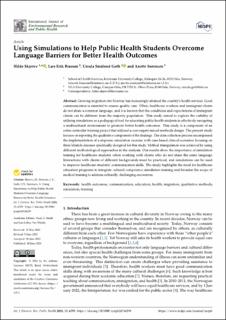| dc.contributor.author | Skjerve, Hilde | |
| dc.contributor.author | Braaum, Lars Erik | |
| dc.contributor.author | Goth, Ursula-Georgine Småland | |
| dc.contributor.author | Sørensen, Anette | |
| dc.date.accessioned | 2023-11-16T17:44:59Z | |
| dc.date.available | 2023-11-16T17:44:59Z | |
| dc.date.created | 2022-12-16T08:44:41Z | |
| dc.date.issued | 2023 | |
| dc.identifier.citation | Int. J. Environ. Res. Public Health 2023, 20 (13) | en_US |
| dc.identifier.issn | 1661-7827 | |
| dc.identifier.uri | https://hdl.handle.net/11250/3103083 | |
| dc.description.abstract | Growing migration into Norway has increasingly strained the country’s health services. Good communication is essential to ensure quality care. Often, healthcare workers and immigrant clients do not share a common language, and it is known that the conditions and expectations of immigrant clients can be different from the majority population. This study aimed to explore the viability of utilizing simulations as a pedagogical tool for educating public health students in effectively navigating a multicultural environment to promote better health outcomes. This study is a component of an extra-curricular training project that utilized a convergent mixed-methods design. The present study focuses on reporting the qualitative component of the findings. The data collection process encompassed the implementation of a stepwise simulation exercise with case-based clinical scenarios focusing on three lifestyle diseases specifically designed for this study. Method triangulation was achieved by using different methodological approaches in the analysis. Our results show the importance of simulation training for healthcare students when working with clients who do not share the same language. Interactions with clients of different backgrounds must be practiced, and simulations can be used to improve healthcare students’ communication skills. The study highlights the need for healthcare education programs to integrate cultural competence simulation training and broaden the scope of medical training to address culturally challenging encounters. | en_US |
| dc.language.iso | eng | en_US |
| dc.relation.uri | https://www.mdpi.com/1660-4601/20/13/6259 | |
| dc.rights | Navngivelse 4.0 Internasjonal | * |
| dc.rights.uri | http://creativecommons.org/licenses/by/4.0/deed.no | * |
| dc.subject | health outcomes | en_US |
| dc.subject | communication | en_US |
| dc.subject | education | en_US |
| dc.subject | health | en_US |
| dc.subject | migration | en_US |
| dc.subject | qualitative methods | en_US |
| dc.subject | simulation | en_US |
| dc.subject | training | en_US |
| dc.title | Using Simulations to Help Public Health Students Overcome Language Barriers for Better Health Outcomes | en_US |
| dc.title.alternative | Using Simulations to Help Public Health Students Overcome Language Barriers for Better Health Outcomes | en_US |
| dc.type | Peer reviewed | en_US |
| dc.type | Journal article | en_US |
| dc.description.version | publishedVersion | en_US |
| dc.source.volume | 20 | en_US |
| dc.source.journal | International Journal of Environmental Research and Public Health (IJERPH) | en_US |
| dc.source.issue | 13 | en_US |
| dc.identifier.doi | 10.3390/ijerph20136259 | |
| dc.identifier.cristin | 2094107 | |
| dc.source.articlenumber | 6259 | en_US |
| cristin.ispublished | true | |
| cristin.fulltext | original | |
| cristin.fulltext | original | |
| cristin.qualitycode | 1 | |

